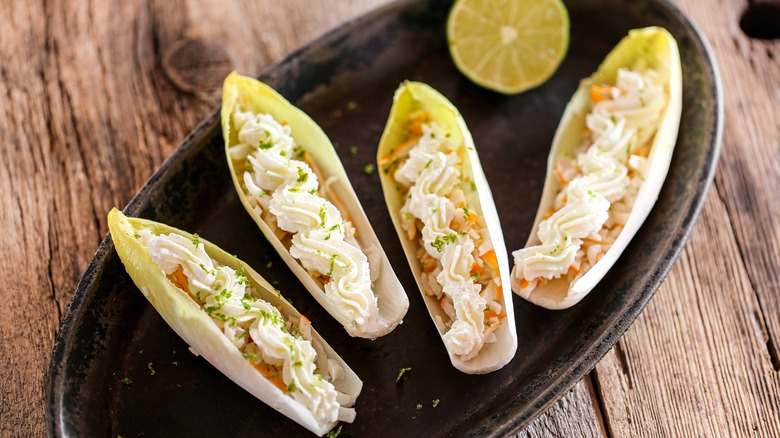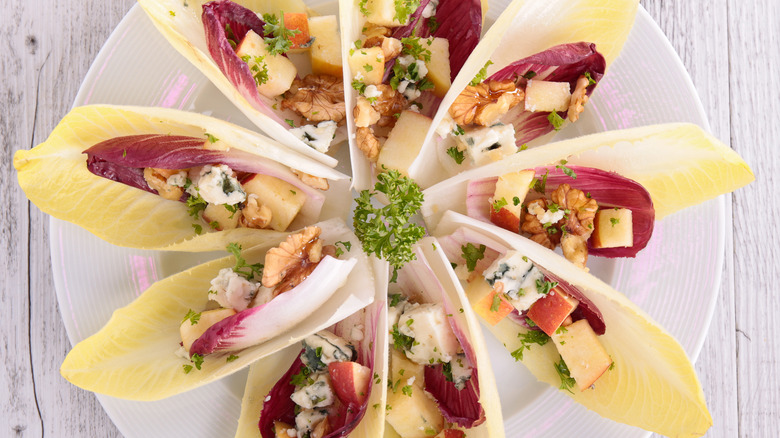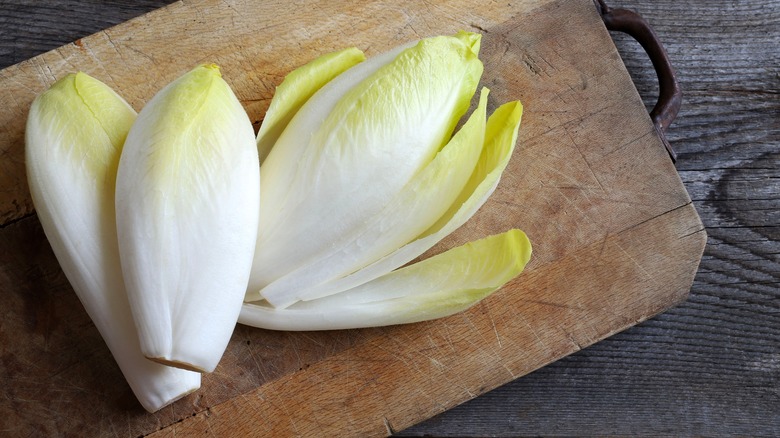The Underrated Veggie That Works Wonders As An Edible Cup
Serving appetizers can become a little same-old after a while. We tend to revisit old standbys and save our ingenuity for the main course when entertaining. But there's one veggie that will not only bring an element of elegance and spectacle to your appetizer spread but will also help you rein in service-related waste like toothpicks and actual cups. The crunchy, flavorful, and uniquely shaped endive is the any-occasion answer to your appetizer conundrums.
Endive is a tasty vegetable, versatile in its own right for salads and braises, but it also happens to have a sturdiness and shape that allows it to function as a sort of edible cup. The prep of separating the leaves is hardly more work than removing paper cups from a sleeve, and it's even an ideal alternative to chips for dips like guacamole or tahini. Size-wise, they are a perfect bite or two, have a satisfying crunch factor, and their pleasant bitterness adds balance to so many flavor profiles.
Elaborating on endive
Endive is in the chicory family, along with various forms of radicchio and dandelion. Much like other veggies in its family, it has a slightly bitter flavor. The important distinction, however, between its common relatives like radicchio and escarole here is its shape. Instead of a round lettuce-like head like radicchio, certain varieties of endive look more like a tiny canoe, and once broken down, have a small cavity that can be filled with a variety of ingredients.
When going for this appetizer or snack cup situation, you'll want to source specifically Belgian endive or red endive, as they are more structurally suited than their cousins (escarole and frisée, which are more tender and curly, and wouldn't be able to hold your ingredients).
Preparing your endives to use as cups is simple, although what you need to know about cooking with endives in general holds true: Make sure to select the freshest produce possible. Check to be sure that the leaves are firm (not wilted or brown), which will ensure that they are at their most crunchy and tasty, and also able to hold the ingredients with which you choose to fill them.
Prepping and filling your endive cups
To make your cups, the prep almost takes care of itself. Simply cut off the base — about ½ inch should do it — and then slice the tube-like length of the vegetable the long way. At this point, you can separate those leaves easily, then wash and dry them (use a paper towel or a salad spinner, if you have one). Your leaves will be varying sizes, as they are nested within one another, but most of them will be large enough to hold your filling. For those that aren't large enough, you can incorporate them into a salad or even roast them.
When it comes to what you put in your endive "cups," you can be creative — just keep in mind the bitterness of the leaves. Waldorf salad stuffed endive cups make great use of the natural sweetness that pears and balsamic glaze bring to the table, and pair perfectly with the funky gorgonzola cheese. Similarly, ingredients that have a good dose of natural sugars, like butternut squash, beets, or sweet potatoes make great complements, while textural pops from candied nuts or pomegranate seeds, and brightness from citrus segments are always welcome elements. A silky cheese like chevre or creme fraiche helps tie things together or go for a creamy homemade hummus, which also brings that beloved nutty, garlicky profile. There are so many ways to make your endive cups that you'll never feel bored by your appetizer spread again.


